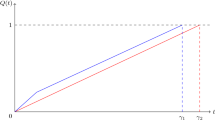Abstract
Randomized load balancing greatly improves the sharing of resources while being simple to implement. In one such model, jobs arrive according to a rate-αN Poisson process, with α<1, in a system of N rate-1 exponential server queues. In Vvedenskaya et al. (Probl. Inf. Transm. 32:15–29, 1996), it was shown that when each arriving job is assigned to the shortest of D, D≥2, randomly chosen queues, the equilibrium queue sizes decay doubly exponentially in the limit as N→∞. This is a substantial improvement over the case D=1, where queue sizes decay exponentially.
The reasoning in Vvedenskaya et al. (Probl. Inf. Transm. 32:15–29, 1996) does not easily generalize to jobs with nonexponential service time distributions. A modularized program for treating randomized load balancing problems with general service time distributions was introduced in Bramson et al. (Proc. ACM SIGMETRICS, pp. 275–286, 2010). The program relies on an ansatz that asserts that, for a randomized load balancing scheme in equilibrium, any fixed number of queues become independent of one another as N→∞. This allows computation of queue size distributions and other performance measures of interest.
In this article, we demonstrate the ansatz in several settings. We consider the least loaded balancing problem, where an arriving job is assigned to the queue with the smallest workload. We also consider the more difficult problem, where an arriving job is assigned to the queue with the fewest jobs, and demonstrate the ansatz when the service discipline is FIFO and the service time distribution has a decreasing hazard rate. Last, we show the ansatz always holds for a sufficiently small arrival rate, as long as the service distribution has 2 moments.
Similar content being viewed by others
References
Azar, Y., Broder, A., Karlin, A., Upfal, E.: Balanced allocations. In: Proc. 26th ACM Symp. Theory Comp., pp. 593–602 (1994)
Athreya, K.B., Ney, P.E.: Branching Processes. Springer, Berlin (1972)
Bramson, M.: Stability of queueing networks. In: École d’Été de Probabilités de Saint-Flour XXXVI—2006. Lecture Notes in Mathematics, vol. 1950. Springer, Berlin (2008)
Bramson, M.: Stability of join the shortest queue networks. Ann. Appl. Probab. 21, 1568–1625 (2011)
Bramson, M., Lu, Y., Prabhakar, B.: Randomized load balancing with general service time distributions. In: Proc. ACM SIGMETRICS, pp. 275–286 (2010)
Bramson, M., Lu, Y., Prabhakar, B.: Decay of tails at equilibrium for FIFO joint the shortest queue networks. To appear in Ann. Appl. Probab. (2012)
Chung, K.L.: A Course in Probability Theory, 2nd edn. Academic Press, New York (1985)
Davis, M.H.A.: Markov Models and Optimization. Chapman & Hall, London (1993)
Dynkin, E.B.: Markov Processes, vol. 1. Springer, Berlin (1965)
Foss, S., Chernova, N.: On the stability of a partially accessible multi-station queue with state-dependent routing. Queueing Syst. 29, 55–73 (1998)
Graham, C.: Chaoticity on path space for a queueing network with selection of the shortest queue among several. J. Appl. Probab. 37, 198–211 (2000)
Graham, C., Méléard, S.: Chaos hypothesis for a system acting through shared resources. Probab. Theory Relat. Fields 100, 157–173 (1994)
Harris, T.E.: The Theory of Branching Processes. Springer, Berlin (1963)
Luczak, M., McDiarmid, C.: On the power of two choices: Balls and bins in continuous time. Ann. Appl. Probab. 15, 1733–1764 (2005)
Luczak, M., McDiarmid, C.: On the maximum queue length in the supermarket model. Ann. Probab. 34, 493–527 (2006)
Martin, J.B., Suhov, Y.M.: Fast Jackson networks. Ann. Appl. Probab. 9, 840–854 (1999)
Mitzenmacher, M.: The power of two choices in randomized load balancing. IEEE Trans. Parallel Distrib. Syst. 12(10), 1094–1104 (2001)
Thorisson, H.: Coupling, Stationarity, and Regeneration. Springer, New York (2000)
Vvedenskaya, N.D., Dobrushin, R.L., Karpelevich: Queueing system with selection of the shortest of two queues: an asymptotic approach. Probl. Inf. Transm. 32(1), 15–29 (1996)
Acknowledgements
Maury Bramson is supported in part by NSF Grants CCF-0729537 and DMS-1105668. Balaji Prabhakar is supported in part by NSF Grant CCF-0729537 and by a grant from the Clean Slate Program at Stanford University.
Author information
Authors and Affiliations
Corresponding author
Rights and permissions
About this article
Cite this article
Bramson, M., Lu, Y. & Prabhakar, B. Asymptotic independence of queues under randomized load balancing. Queueing Syst 71, 247–292 (2012). https://doi.org/10.1007/s11134-012-9311-0
Received:
Revised:
Published:
Issue Date:
DOI: https://doi.org/10.1007/s11134-012-9311-0




